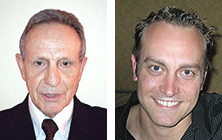In 1982 a 23-year-old Caucasian male developed a flu-like illness, accompanied by vomiting, headache, disorientation, and insomnia. He was diagnosed with herpes simplex virus (HSV) encephalitis and treated with antiviral medication.
Profound memory problems were immediately apparent. His short-term memory was most affected. Long-term memory was less affected. He confabulated extensively. Attention and working memory were relatively unaffected. Procedural memory, as judged by his ability to perform daily grooming tasks, was unaffected.
MRI of his brain showed dramatic cystic encephalomalacia involving the anterior two-thirds of the right temporal lobe and approximately one-half of the anterior left temporal lobe. The tissue destruction also extended into the cingulate gyri and orbitofrontal cortices bilaterally.
There has been little improvement in his memory. His attention remains mostly intact. Recent verbal and nonverbal memory remains impaired. He can name common objects, but cannot name or describe the function of modern objects such as computers, compact disks, or pagers. He cannot, when asked, place himself into yesterday by providing details of what he did or the circumstances in which he found himself. Similarly, he cannot, when asked, imagine a tomorrow by providing any immediate or long-term plans or desires. He has neither recent memories nor any future hopes and exists entirely in the present. Not angry, anxious, or sad, he is perpetually content in the now.
A comprehensive neuropsychological testing battery demonstrated severe impairment in verbal and nonverbal memory, significant executive function difficulty, with relative preservation of other cognitive intellectual capacities.
Discussion
HSV is the most frequent causative agent among infectious encephalitidies, with an incident rate of 1 million to 3 million cases a year. When HSV encephalitis is suspected, antiviral treatment with 10mg/kg IV acyclovir TID should be instituted immediately. Although the early use of acyclovir has reduced the mortality to approximately 10 percent, over 50 percent still suffer severe neurological impairment including profound memory disturbances attributable to HSV’s proclivity for localizing in the medial temporal and frontal areas, neuroanatomical structures critical in the neurophysiology of memory
Memory is now understood to be a nonunitary complex process that is subdivided into different capacities that utilize different neural circuitries. The classification of these systems has become increasingly complex (Budson and Price, 2007). A major distinction is made between explicit memory-acquired information/experience that can be verbally reported and implicit memory-acquired information/experience that is unconscious and not readily verbalized or declared and mostly expressed as recallable motor skills.
Explicit (declarative) memory is divided into episodic memory (similar but not identical to the old term “recent memory”), semantic memory (similar but not identical to the old term “remote memory”), and working memory (similar but not identical to the old term “immediate memory”). Implicit (nondeclarative) memory’s main taxonomical subdivision is procedural memory. Procedural memory is skill memory. It can be conceptualized as the mind’s ability to learn a sequence or task, usually motoric in nature. The anatomical structures that subserve this memory system are also integral to modifying motor activity—namely the cerebellum, basal ganglia, and supplementary motor cortex (Budson and Price, 2005).
Working memory is the most transient of the memory systems and likely the most neuroanatomically widespread. Working memory has evolved to mean a composite of both the attentional matrix (consciously holding the information in mind) and memory manipulation—the “working” part. Working memory has a widespread cortical and subcortical localization. One neuroanatomical commonality, however, is the dorsolateral prefrontal cortex.
Episodic memories are recallable experiences that are fixed to a specific time and place. Episodic memory is centered in the hippocampus, with significant contributions from other medial temporal lobe structures, the Papez circuit, the prefrontal area, and the parietal lobes.
Autobiographical memory and autonoetic consciousness are intimately tied to episodic memory. Autonoetic consciousness is a concept originally advanced by Endel Tulving that denotes the uniquely human capacity to place ourselves in time, self-reflect using past memories, imagine ourselves in the future, and thus influence our behavior (Tulving, 1985). Failure of autonoetic consciousness not only erases past recollections, but also the ability to put oneself in the future. Neuroanatomically the hippocampus and the parietal lobes are critical for autonoetic consciousness.
Source memory is the recollection of the context around a specific memory and is unique to the episodic memory system. The frontal lobes are integral to source memory (Budson, 2009). Frontal lesions result in memories that lack context; the memories become difficult to link with other memories or to an internal time sequence. Failure of source memory may underpin the phenomenon of confabulation, which is a prominent feature of frontal lobe damage, and may represent an unconscious compensatory attempt to create context around these decontextualized memories.
Semantic memory is the term applied to memories that can no longer be clearly recollected but still maintain an element of familiarity and broadly describes the process of remembering and using decontextualized facts (Saumier and Chertkow, 2002). The inferior-lateral temporal lobes are the main storage site for the semantic memory system (Budson and Price, 2005). Unlike episodic memory, semantic memory has no associated self or source, meaning that we remember the fact or figure, but we do not associate it with any specific time period or episode in our life.
Understanding these various memory capacities and their neuroanatomical substrates is helpful in understanding this patient’s clinical presentation. His encephalitis spared his cerebellum, basal ganglia, and supplementary motor cortex. Thus, his procedural memory was seemingly unaffected within the context of his highly custodial environment. He had severe, bilateral involvement of his medial temporal lobes, which resulted in maximal impact on his episodic memory system. He also had a superimposed semantic memory deficit, either attributable to the damage of his inferior-lateral temporal lobes or to the long-term effect of persistent profound episodic memory failure preventing the transfer into and hence the formation of updated semantic memory. His tendency to confabulate was likely a problem with source memory stemming also from his frontal injury. Lastly, his injuries have profoundly altered his autobiographical memory and his autonoetic consciousness: in his world, there is no past and no future. ■
References
Budson AE: Understanding memory dysfunction. Neurologist 15:71-79, 2009
Budson AE, Price BH: Memory dysfunction. N Engl J Med 352:692-699, 2005
Budson AE, Price BH: Memory dysfunction in neurological practice. Pract Neurol 7:42-47, 2007
Saumier D, Chertkow H: Semantic memory. Curr Neurol Neurosci Rep 2:516-522, 2002
Shohamy D, Foerde K: The role of the basal ganglia in learning and memory: insight from Parkinson's disease. Neurobiol Learn Mem 96:624-636, 2011
Steiener I: Herpes simplex virus encephalitis: new infection or reactivation? Curr Opin Neurol 24:268-274, 2011
Tulving E: Memory and consciousness. Can Psychol 26:1-12, 1985

